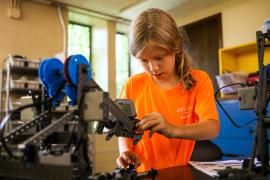We will call him, Mr. Joe. An eighty-one-year-old former resident of New Orleans, Mr. Joe tells Canon Walter Friese, interim director of Hardnter Camp and Conference Center in Pollock, Louisiana, about his aching arms as he swam his way to safety through the swirling waters of a devastated city in the midst of a catastrophe that many of us could never imagine. "Mr. Joe was so gracious and kind to those suffering around him. I would watch him listen to other's stories with such compassion while he constantly reassured them as he believed others were suffering more than he was," said Friese, "You would never know that he just encountered a life-threatening experience that he not only survived, but came through with the desire to help others."
During and after Hurricanes Katrina and Rita rattled the Texas and Louisiana coasts and beyond in the late summer and early fall of 2005, many stories like this one of human loss, victory, and salvation were being heard by camp directors as they opened their doors to evacuees.
Open Gates, Open Hearts
When Hurricane Rita was just a prediction, Jane Ragsdale, camp director of Heart O' The Hills in Hunt, Texas, began receiving calls from camper parents wanting to stay at the camp. With desperate voices they would ask to bring their families because all of the hotels in the surrounding cities were booked, recalled Ragsdale.
Scrambling to prepare for at least 130 evacuees, Ragsdale made arrangements with local vendors, who made special deliveries of food and linens. A local drug and alcohol rehabilitation center loaned blankets and pillows. "Families began arriving at all hours, some in the middle of the night. I left a walkie talkie on the desk in the office with a big note telling them to call me when they arrived. I would sleep on my couch with the walkie talkie at my ear," said Ragsdale. "The families were coming from Houston and Galveston, which would normally be a five-hour drive. It took some families twenty hours in grid-locked traffic to reach the camp. They would arrive exhausted but relieved. One family had an infant daughter. They were so grateful to stay, they told us: ‘You will see my daughter at this camp in six years.'"
In the rolling hills of Midlothian, Texas, surrounded by giant mesquite trees and fields, Camp Hoblitzelle and its small staff began preparing for over 100 evacuees from Hurricane Katrina. After responding to the county judge's request to become a host site, the camp was linked with the city of Midlothian's emergency management system.
"Our first bus load of 120 evacuees from the New Orleans Superdome arrived at 2:00 a.m. We wanted to take steps to provide a safe environment. Our city officials provided screening services, a portable metal detector, and local EMS workers did preliminary medical questionnaires," said John Horton, executive director of Camp Hoblitzelle. "Many of them arrived with a handful of belongings in a garbage bag, and they had not slept or eaten in days. We provided them with sack lunches so they could eat right away. Hurricane Katrina evacuees stayed with us eleven days, and 160 Hurricane Rita evacuees stayed only five days. In both instances, our local police department went above and beyond, supplying two officers on twenty-four-hour duty to help. Our initial group of evacuees had been through rough experiences, and this helped them feel secure."
Overcoming Challenges
Many challenges were faced and conquered by host-site camps as they took in the frightened evacuees from both hurricanes. The LA Lions Camp in Leesville, located in west central Louisiana, was on the fringe of Hurricane Rita's wrath and lost electrical power and water while hosting Hurricane Katrina evacuees. "We had a supply of bottled water at the camp, and that supply became very valuable. Local families and friends of the camp pitched in and hauled water to us. By the time the water and power came back on, we were in pretty good shape," said Ray Cecil, camp director.
The medical needs of evacuees also posed a challenge. The LA Lions Camp served as a special needs camp during normal operation and was familiar with the special requirements of diabetics. "We had several elderly people among our evacuees who had diabetes. Through our local community suppliers, we were able to provide them with the supplies they needed. We also set up a Diabetes Relief Center in Baton Rouge, helping evacuees with free testing equipment and oral medications," said Cecil.
Meeting Needs
Host-site camps worked diligently to meet the needs of their evacuees. Almost immediately they needed access to phones and the Internet to make FEMA registrations or to connect with family and friends. Camp Hoblitzelle developed an intake form for each evacuee. "Once their basic food and shelter needs were taken care of, we began to work on the social service side of the issues. We sat down with them and took basic information, asking them questions: Where do you need to go? Where do you want to relocate? We helped them make decisions. Many of the evacuees came from inner-city environments and depended solely on public transportation. They often did not have driver's licenses. We transported some to the Dallas area. We wanted to help them get to an environment where they could continue their normal lives. About 50 percent to 60 percent of our evacuees reconnected with family and friends. The other 40 percent relocated to the greater Dallas area," explained Horton.
Kathy Naish, operations manager for Briarwood Retreat Center in Argyle, Texas, whose camp hosted approximately 196 evacuees from New Orleans provided televisions, Internet access, and snacks for the evacuees in the cabins. "We also assisted them with enrolling their children in school and finding jobs in the local area. Eventually, many of the evacuees found apartments in the surrounding cities."
Camps and Communities Working Together
Often camps made community connections to increase the outreach to hurricane victims.
"It's one person at a time solving one issue at a time," said Laurie Johnston, executive director of Camp Carter YMCA of Metropolitan Fort Worth, Texas. Camp Carter mobilized a 1,000 member volunteer effort from the local community to assist evacuees from the New Orleans Superdome and convention center who where housed at the camp. "We had an incredible grassroots volunteer effort that set up a computer lab of twenty-five computers for our evacuees. Volunteers solicited the donated computers from Pier One. Southwestern Bell donated the broadband network, and one volunteer who owned a computer consulting firm, set the lab up overnight," said Johnston. "We knew the evacuees could not move forward until they got back with family members. They were frozen until connected with their families. The evacuees were able to come in and look for loved ones and job opportunities over the Internet. In the first week after Hurricane Rita, 5 percent of nationwide matches of people missing as a result of the hurricane came from Camp Carter."
"As far as seeing the worst of mother nature, we saw the best in humankind," said Stephen Mabry, executive director of Texas Lions Camp in Kerrville, Texas. Mabry's camp worked with a community nursing care facility to provide housing and meals for nursing care professionals and their families in both Kerrville and San Antonio, Texas. The project was called Operation TLC. "Nursing care workers came with their families and belongings to our camp. They commuted daily to the nursing homes to give care. Everybody rolled up their sleeves to help."
Camp Bon Coeur in Lafayette, Louisiana, brought happy smiles back again to the children of Hurricane Katrina evacuees. The camp organized A Day in the Park for children of hurricane evacuees. Bringing their own camp equipment to the rental facility where they ordinarily do summer programming, the camp staff provided a mini-camp for the children housed at the rental facility. The children, ages four to seventeen, did marble painting, played games, and enjoyed a day at camp. The camp staff brought care packages for the children with stuffed animals, clothes, and toys. "Several parents came up to us and said this was the first time since the hurricane that they had seen their children smile and laugh," said Susannah Craig, executive director of Camp Bon Coeur. "It was nice for me as a director to see how much my staff was willing to give back at a moment's notice and to volunteer their time to organize this event."
Stories of Hope and Lasting Bonds
The vast community response and volunteer mobilization in the areas affected by the hurricanes proves that the resilient human spirit still remains. Stories of hope and courage are blossoming from the camps that helped the hurricane victims.
For instance, Kathy Naish, operations manager for Briarwood, remembered Essence and her family that came to stay at her retreat center: "Essence was a seven-year-old who along with her parents and younger sister were pulled from a flooded area after being in water for twenty-four hours. Her family was being housed in the Louisiana Superdome. When her family finally reached our facility, the father had not slept for days because he felt he had to stay awake and guard his family. For the first time in her life, Essence saw nature and the woods. She and her little sister now come to visit us once a week. Her family has now relocated, and her father is now employed at the University of North Texas. They are driving a donated car. They lost everything, but they have hope and a new beginning."
"One family that stayed at our camp was able to find their missing sisters at another Dallas shelter through the Internet. We were able to go pick family members up and bring them here. A sister, mother, and her children were reunited. It was a joyous meeting and amazing to witness," said Horton, executive director of Camp Hoblitzelle.
"Many volunteers and staff were profoundly changed by the aftermath of the hurricanes and helping the evacuees. When you take someone who has lost everything in their life, and you are able to help them, you find out how much alike you really are. All the barriers are broken down," said Naish. "We held a volunteer appreciation dinner at our camp and invited the evacuees. Every one of them returned. I just sat back and watched the friendships emerge and the change in these people. They were sitting down with each other swapping stories about growing up and life. We had become family."
Originally published in the 2006 March/April issue of Camping Magazine.




